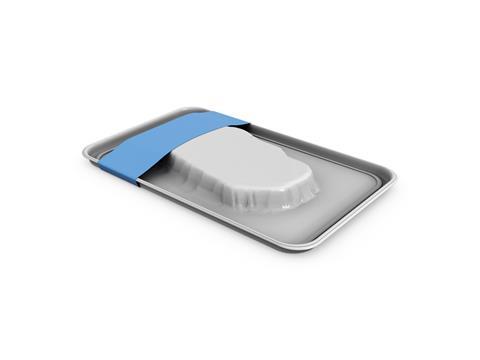
According to Michael Reffke, product manager for marking at MULTIVAC’s Marking & Inspection unit, full wrap labels offer a broad range of competitive advantages in comparison to other labelling solutions and are increasingly becoming an important design element of retail packs.
This way, Reffke says, they help brand owners to increase the differentiation of their products at the point of sale and to offer further value to the consumer.
Full wrap labelling solutions can be designed very flexibly for a wide range of pack shapes and materials, so the optimum labelling result will always be achieved. Typical applications include skin packs with different heights of product protrusion or products that are lower than the tray itself.
Since unprinted upper webs are mostly used on skin packs, the label plays an important role with these packs in distinguishing the product. Full wrap labels can also be used on thermoformed MAP packs or trays in a wide range of shapes.
The even surface of these packs offers multiple positions where the labels can be placed. Also, clamshells, which are widely used for ready-made salads, fresh fruit or bakery products, can benefit from an improved shelf impact provided by full wrap labelling. In this case, the label also serves the purpose of sealing the clamshell.
Due to their flexibility in size and form, full wrap labels offer a maximum area for branding and product information and do not block product visibility. Full wrap labels also give promotional possibilities on the reverse side which are visible only after the purchase of the product.
As food packs are often piled up on the shelf, full wrap labels will increase the visibility of the product on the shelf. In order to allow full visibility of the packed product, transparent label materials can also be used.
Full wrap labels can be designed in a way that offers additional features to the package, increasing its convenience.
For example, adhesive-free zones on the label or perforations can be used allowing for easy opening of the packs or label removal. Recipes, cooking information, or promotional items can be printed on the backside of the labels. In addition, full wrap labels can add a tamper-evident functionality to the package, enabling customers to see if the package has been manipulated.
Cardboard sleeves, which have a high-quality image of the brand, have to be processed manually and require an additional label on the rear to attach the sleeve to the pack. Due to that fact, this type of packaging involves significant extra cost when compared with automatic full wrap labelling.
Full wrap labelling can, therefore, offer an attractive alternative, particularly when paper labels with a higher grammage are used. By incorporating scores, i.e. pre-determined creases in the label, the high-quality sleeve look can even be enhanced.
In addition to the advantage of high-level automation, full wrap labelling also offers the benefit of security. One aspect here is that self-adhesive labels do not fall off as easily as cardboard sleeves during logistic processes such as secondary packaging, transport or in-store shelf filling. A second asset in terms of security is that customers have no possibility of switching the label with that of a similar but lower-priced product.
Especially with regards to design and shape, full wrap labels benefit from greater flexibility. Whereas “linerless” labels can only be produced in a rectangular format, all shapes can be considered for self-adhesive labels, since they are “held” in effect by the carrier paper. Labels with curves or cut-outs, for example, are possible with self-adhesive labels, which means they can be matched to the shape of the particular product or pack. This also applies to the range of materials, which can be used for the production of self-adhesive labels – this is much wider than for “linerless” labels since the carrier material for the self-adhesive labels has a stabilising effect on the label material.
Another aspect, which restricts the efficiency of “linerless” labelling systems, is the fact that running these materials causes increased cleaning work on the machine. Labelling machines for running “linerless” labels also have to be equipped with knives, so the labels can be cut from the endless label stock.
Residue of the adhesive or silicone layer on the labels builds up on these knives, which means they have to be cleaned regularly in order to maintain optimum labelling. The machine running time is therefore reduced significantly.
Especially with regards to design and shape, full wrap labels benefit from greater flexibility. Whereas “linerless” labels can only be produced in a rectangular format, all shapes can be considered for self-adhesive labels, since they are “held” in effect by the carrier paper.
Labels with curves or cut-outs, for example, are possible with self-adhesive labels, which means they can be matched to the shape of the particular product or pack. This also applies to the range of materials, which can be used for the production of self-adhesive labels – this is much wider than for “linerless” labels since the carrier material for the self-adhesive labels has a stabilising effect on the label material.
Another aspect which restricts the efficiency of “linerless” labelling systems, is the fact that running these materials causes increased cleaning work on the machine. Labelling machines for running “linerless” labels also have to be equipped with knives, so the labels can be cut from the endless label stock.
Residue from the adhesive or silicone layer on the labels builds up on these knives, which means they have to be cleaned regularly in order to maintain optimum labelling. The machine running time is therefore reduced significantly.















